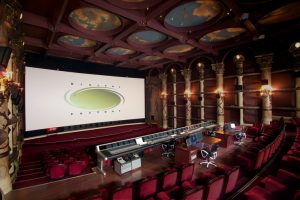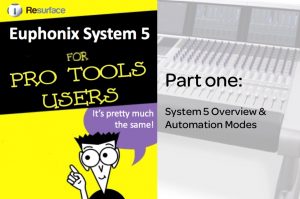
Euphonix System 5 Introduction and history
Formed in 1988, by two former employees of a Silicon Valley based test equipment manufacturer, Euphonix’s first mix system, Crescendo, comprised of a mixing surface with digital control of an analogue processing rack, via an RS422 connection. The system evolved throughout the 1990’s, from the original Crescendo, into the CSII, CS2000 and CS3000, all following a similar ethos of digital mixing surface control of analogue signal paths. As a company, Euphonix grew from launch to IPO listing on the NASDAQ in 1995, being taken private again in 2001 during the post millennium period of technology stock market instability. Euphonix continued to trade privately until their acquisition by Avid, in April 2010.
System 5
Euphonix evolved their mixing surface technology in combination with a new digital engine and subsequently introduced the Euphonix System 5 as a replacement for the CS range. Launched at AES in 1999, System 5 was Euphonix’s first fully digital mixing console.
System 5 introduced a unique rotary encoder knob design, LED’s indicating knob position were incorporated into the top of the knob, the knobs were referred to as Phat knobs due to their large geometry. Euphonix used an assignable knob design, where the 8 knobs on each channel could be assigned to a function such as pan, Eq or Dynamics, making the console easy to operate. The DSP engine comprised of DF64 processing racks, holding 10 DSP cards which used Analog Devices Sharc chips, in a floating point processing core. One to four DF64 engines could be used on a single system. The I/O interface connected over MADI and came in 2 rack space units, either analog to MADI or digital to MADI, in various configurations.
Around 2006, Euphonix updated the engine to a smaller form factor 4 rack space chassis, called the DF66. This engine was available with 2 to 6 DSP cards, which provided similar track counts to the older four chassis DF64 systems, despite having fewer cards. This was due to the update to a more powerful version of the Sharc processor on its SP662 DSP cards. Around that same time, the control surface modules were updated with more traditional touch sensitive knobs, these had a smaller diameter and thus were a little more ergonomic to adjust. Around 2009 Euphonix introduced a larger DF70 DSP core which would take up to 8 DSP cards and provide over 300 channels of processing.
Euphonix also introduced a more cost effective version of System 5 called Fusion. Fusion used exactly the same control surface modules but in a lower cost frame design. The DSP engine core and Studio computer were a single unit that was available with 1 or 2 DSP cards, providing up to 96 channels of processing. A Fusion can be expanded to a regular System 5 by adding more processing with the addition of a DF66 DSP core.
Later DF66, DF70 and Fusion cores from around the time Avid acquired Euphonix in 2010 were shipped with a newer DSP card, the SP663. This card updated the Sharc DSP chips from 100MHz to 120MHz versions, providing more processing power.
Euphonix also produced a control surface only version of System 5, called the System 5MC, in 2004. The 5MC used the same 408 channel modules as a System 5, alongside a completely different master section with integrated keyboard and either 4 faders or a joystick. This was based on the MC Pro standalone controller. The System 5MC used the same lower cost frame as the Fusion console and controlled an attached workstations via the EUCON control protocol.System 5 and 5MC were discontinued following Avid’s launch of S6, the 5MC in 2014 and System 5 in 2016.
Links to related online resources:

Resurface & Rich Morson’s ultimate Euphonix System 5 guide for Pro Tools Users
Avid’s System 5 and 5MC and MC Pro documentation and software page
Detailed System 5 launch review at Mix Online
System 5 user group on Facebook